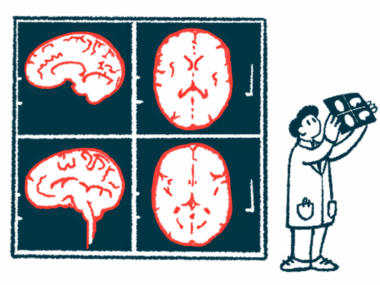Migraines are common in multiple sclerosis, but mine aren’t
A columnist describes his 'silent' migraines
Written by |

Migraines are quite an experience. People who have them wish they didn’t. I occasionally do, but I’m hesitant to compare myself with others. I’m even reluctant to use the word “migraine” to describe mine, because while I have many of the symptoms of a migraine, I don’t have any of the head pain.
Mine are referred to as migraine aura without headache, or “silent” migraines. While the experience is unpleasant, I’ve been told it’s very different from those with pain. A particularly cynical friend who routinely has them told me the difference between our experiences is like having a cavity filled with and without anesthesia. He stopped short of saying I was lucky, but it still feels a little dishonest to say I have migraines without prefacing it with the word “silent.”
Recently, I commented that I tend to attribute every bad thing in my life to multiple sclerosis (MS), but in this case, I don’t think I’m wrong to do so. Headaches of any sort are rare for me, but I still sometimes have them, mostly because of my sinuses. Silent migraines, and their accompanying symptoms, however, are a new experience for me that started after I was diagnosed with MS.
Migraines are relatively common in people with MS. Approximately 1 in 4 people with this disease report having them, but the relationship between the two conditions isn’t fully understood. Damage to certain structures of the brain, inflammation related to MS, and even certain MS medications are suspected of playing a role, but like so many things about this disease, the exact cause is still somewhat of a mystery.
My silent migraines are usually preceded by a visual aura. If my eyes are closed, it feels like someone is shining a flashlight at one side of my head. Occasionally, I’ll see a bright dot of light that’s usually blue or green, as though I’d seen a bright flash of light and had the image burned onto my retina.
On two occasions, I’ve had what is called scintillating scotoma. This could be a blind spot, a flickering point of light, or something you might see in a kaleidoscope. Both times, the ones I experienced were like sawtooth rainbows in the shape of a backward “C.” The first time was more than a little unnerving, but by the second time, I knew what to expect and just enjoyed the light show.
When my silent migraine is in full swing, I have a number of the usual symptoms. My senses become extremely sensitive and make me want to avoid light, noise, touch, and even smell. My pulse pounds in my head, to the point that I feel like I can hear my own heartbeat. My vision is blurry, but maybe that’s because when my eyes aren’t closed or protected by a dark room, they’re only opened in narrow slits. All of that steals my energy and leaves me fatigued. I can’t imagine what it’s like with pain.
When I first described the symptoms I was having to my neurologist, he looked at me for a second, then told me that I had perfectly described a migraine, but without the headache. He originally prescribed a medication to lower my blood pressure, which would dilate the blood vessels in my brain. When this didn’t work, he recommended a drug called sumatriptan, which specifically treats migraines and is taken as needed. It seems to be working well, but the directions indicate that it shouldn’t be taken until the pain starts, so I feel like I’m winging it.
As unpleasant as it can be, our pain response is there for a reason. Pain lets us know that something is wrong. It’s our cue to do something to alleviate it. Believe me, I feel fortunate to not have the pain, but I almost feel like I’m being robbed because I’m having to rely on other cues to know when to treat the condition.
I don’t have a particularly high pain tolerance — just ask my wife. A migraine aura without a headache is frustrating and even a little scary at times, but I seriously doubt I could stay silent if I’d have a typical one. I hope I don’t have to find out.
My hat is off to all of you who routinely deal with them. This MS symptom really is “all in your head” — and I’m sorry.
Note: Multiple Sclerosis News Today is strictly a news and information website about the disease. It does not provide medical advice, diagnosis, or treatment. This content is not intended to be a substitute for professional medical advice, diagnosis, or treatment. Always seek the advice of your physician or other qualified health provider with any questions you may have regarding a medical condition. Never disregard professional medical advice or delay in seeking it because of something you have read on this website. The opinions expressed in this column are not those of Multiple Sclerosis News Today or its parent company, Bionews, and are intended to spark discussion about issues pertaining to multiple sclerosis.







John Coughlin
I suffered from horrible migraines up to the age of thirty. Not particularly frequent (1-2 per month), they were very painful and debilitating, culminating in an attack of, what the doctor called, cluster migraines (1-2 per day, with visual disturbance, vomiting and half-body numbness). After this attack they suddenly stopped altogether (breathes a huge sigh of relief...). When diagnosed with MS at the age of 49, I too asked the neurologist if there could be a connection, to which he just shrugged and said it was possible but unknown/unproven. I've been taking Tecfidera since my diagnosis. To my horror, I began to experience exactly the same visual disturbances that preceded a migraine when I was younger but this time (to me, almost unbelievably) without any pain (another huge sigh of relief...). Currently about once or twice a month; but I just sit it out, wait for the disturbances to stop, and carry on as before. Migraines/MS/Optic neuritis/DMT - I feel there must be a connection somewhere, somehow, but no-one seems to know. The possible connections/associations are fascinating.
Benjamin Hofmeister
Hi John and thanks for the comment! I'm not a doctor of any sort, but the more I learn about MS, the more I realize, not just how much I don't know, but how much even the experts don't know. I think you're right, there must be a connection of some sort. I hope they figure it out sooner rather than later
Cynthia MacFarlane
Before my diagnosis of MS in 1987, I would see those flashes of blue or green "neon" lights while I was reading late at night. Since then I have had episodes where I feel generally unwell and see a letter "C" composed of broken pieces of mirror . I don't get the headache either , but do feel "blah" and am very tired.When I described it to my family doctor , she thought I had had a stroke ! It was my eye doctor that knew it was a migraine.
Thanks for your column ! Always interesting.
Benjamin Hofmeister
The first time I ever saw the backwards C, I thought I was having a stroke too. My coworkers at the time were probably wondering why I kept shrugging my shoulders, smiling, and saying things like you can't teach an old dog new tricks.
I wonder why a c shape is so common?
Rosanne Costain
My sympathies to anyone who suffers headaches or "auras". I was fortunate in one study I participated in (angiogram). It ended my MS headaches almost immediately. It also helped reduce the numbness and tingling in my feet and hands - still there but far less.
Benjamin Hofmeister
Thanks for the comment Roseanne! And thank you for the news about your angiogram! It's amazing that that has never been mentioned before, or maybe it has and I just wasn't paying attention. Either way, I think I'm going to bring that up and my next neurology visit.
Jane Foord
Hi Ben Thanks for this article. I have both sorts but more of the aura. Nice to know I’m not alone.
Benjamin Hofmeister
Hi Jane, no, you're not alone. I'm sorry you have the other kind. Do you get the auras before that kind too?
Glenda Hendry
I’ve never had a silent migraine, but I’ve suffered with traditional migraines and experienced “lightening migraines” when visiting a mountainous area. You definitely don’t want to experience the latter. Since the contrast dye stays in the brain after an MRI, I’ve often wondered I’d it plays a role in migraines.
Benjamin Hofmeister
Thanks for the comment Glenda! Or you want to never considered the contrast dye, but I will now!
Patti
You are having an ocular migraine. It is a migraine. I have MS and I have them quite sporadically.. sometimes frequently like daily or weekly sometimes months will go by without one. I'm just happy I no longer have the pain. I deal with it but using eye masks and an inhaler called Migrastil which works for me. The sooner I get into the dark and use the inhaler the sooner er it leaves.
Benjamin Hofmeister
Hi Patti and thanks for the comment. I haven't tried an eye mask yet, but yes a dark quiet room is key.
Betty Stoddard
Ben, like you my sympathetic thoughts go out to those who DO suffer from migraines.
And as you have written, I can say echo, echo, echo to almost every word or phrase! One of my physicians quickly discounted the 'aura'...much to my unhappiness. Yet it is a truth, as you well know.
Fortunately if, repeat IF, I take an OTC med at the initial..."I think that was an aura" moment, usually the migraine doesn't happen. Not always true. My aura, or warning cautions, are similar to yours, just combined differently.
Read your wise words regularly, Ben. Respond infrequently...especially if you've had many replies.
All the best that we can have! Betty
Benjamin Hofmeister
Thank you Betty! I'm sorry we're in this boat together, but I guess we should be grateful that we're on a boat. I haven't tried anything over the counter except for ibuprofen which gives mixed results for me. That's not to say I won't keep trying. Thanks for the motivation
Steve Hards
When you have non-typical symptoms (especially when they are happening in your head) it is easy to worry that you have some rare condition. However, a wise doctor once reassured me "You are much more likely to have an unusual symptom of a common condition than a common symptom of an unusual one."
Benjamin Hofmeister
Thank you for the comments Steve! And thanks for sharing what your doctor shared with you. I like that sort of logic and it really applies to multiple sclerosis.
Alex
I also only get the auras - I’ve also had sinus issues. I wonder if it’s all linked… interesting
Benjamin Hofmeister
Hi Alex, I seem to keep a sinus infection these days. I blame it on a combination of Ocrevus making me more prone to upper respiratory infections, having my nose broken three times, and a surgery to straighten out said broken nose. I always associated my son's issues to the occasional sinus headache, but I never thought of a connection between that and Silent migraines. Thanks!
The cranky one
Scintillating scotomas are fun, aren't they - says she somewhat cynically. However, I'll put up with them in preference to any headaches which involve or include pain. I get them in "batches" - none for a few weeks, and then from one to four a day for a week or two. Sometimes mine just turn up and do whatever they want, other time they can be triggered by a sudden flash of light (which doesn't even need to be very bright or strong).
For those who find the word descriptions in the article Ben has linked a bit fuzzy to understand - here's a couple of sites with animations of what scintillating scotomas look like.
https://en.wikipedia.org/wiki/Scintillating_scotoma
https://www.youtube.com/watch?v=OaMvHalPaFg
Benjamin Hofmeister
Hi! I was wondering if you would chime in on that subject. Yes, they are so fun and I'm developing a reputation for being cynical too. I haven't identified any triggering events yet, but I haven't put any serious effort into it either. Perhaps I should.
Thanks for the links too. I often don't think of an article as being fuzzy after I've looked at it for the 10th time. Thanks for the clearer references!
Rhe cranky one
Oh dear - am I being a bit predicable? Blame it on my gallbladder......... :(
I find that the Wikipedia animations are so accurate that I've had medical professionals swoon at my feet for giving them a link they can use with patients when both parties are having trouble connecting on the descriptions need to identify what's going on - it's hard for someone who's never experienced one to describe it to someone who has experienced them but may not have the words/ verbal skills to convey what they are "seeing".
(Well - maybe "swoon" is a bit strong, but a girl's got to take any accolades offered, even if exaggeration is required for re-telling of tales...........:) :) :) )
Benjamin Hofmeister
Not predictable.. just relatable.
And yes, Swoon might have been too strong of a word. I have my doubts that you have ever swooned. 😆 🤣
Nanette Lai
Thank you!
I had no idea that oscillating scotoma was a migraine. Like yourself, my head doesn't hurt.
With most MS symptoms, I simply find them annoying and hope they will pass.
Benjamin Hofmeister
For me it's one of the strange silent symptoms of MS. Silent migraine, silent UTI, and recently a silent bout of pneumonia.